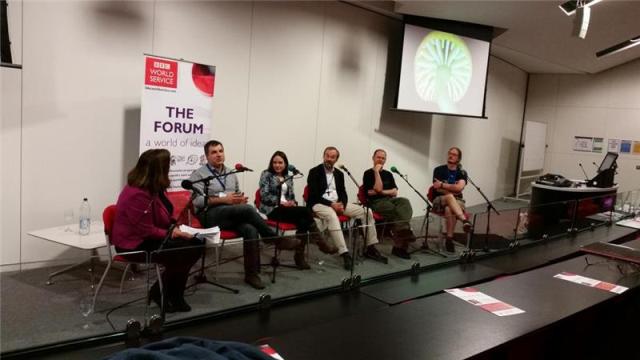Jul 6 2015
Graphene Week 2015 in Manchester saw the BBC World Service in town to record an episode of The Forum – a radio discussion programme that tackles the big questions of our age with some of the world's most eminent thinkers, movers and shakers.
 The panellists record the programme. Copyright 2015 Anders Frick, Chalmers University of Technology
The panellists record the programme. Copyright 2015 Anders Frick, Chalmers University of Technology
Chaired by BBC diplomatic correspondent Bridget Kendall, the panel comprised Nobel laureate Kostya Novoselov and fellow University of Manchester academic Sarah Haigh, Trinity College Dublin-based professor of physical chemistry Jonathan Coleman, Graphene Flagship director Jari Kinaret, and digital arts and robotics researcher Toby Heys from Manchester Metropolitan University. Discussion topics for the panel and audience included the real-world potential of graphene and related two-dimensional materials, the role of Europe's Graphene Flagship in translating graphene products from the laboratory to consumers, and the safety of 2d materials.
Haigh set the ball rolling with an introduction to graphene, and this was taken up by the other panel members, who spoke of their own science and engineering interest in 2d materials. From the chair, Kendall asked whether the materials will live up to their potential, and about the oft-quoted 10-year development lifetime for graphene-based products. Kinaret said that 10 years is a rather short time when it comes to the development of disruptive technologies.
Graphene is one of a large number of interesting 2d materials, albeit the one with the most research and development investment. Graphene will likely underpin a number of technological advances, but not just on its own. Graphene can be combined with other materials in composites and heterostructures. Kendall enquired about graphene heterostructures, giving the experts present a chance to expound on the topic of 2d materials in the round. Kinaret stressed that the Graphene Flagship, its name notwithstanding, is actively engaged in the development of a range of layered materials.
The discussion then moved on to the development and exploitation timeline for graphene, and the introduction of graphene into an environment in which it must compete with established and so far highly successful materials. Silicon, for example, will still be around in 10 years, noted Novoselov, adding that graphene needs to outshine other materials by a significant margin in order to supplant them.
Examples of practical applications for graphene and other 2d materials discussed by the panel include transparent, flexible displays, and biomedical applications such as artificial retinas and various kinds of sensors. Not least in the biomedical field, material safety is paramount. Kendall asked about the safety of nanomaterials, and where graphene fits into the regulatory regime.
Kinaret stressed that the only form of graphene that may properly be classed as a nanomaterial are platelets with nanometre-scale sizes, where edge effects on biological cells are a concern, as they are with other engineered nanomaterials. Larger-area graphene sheets are another matter entirely, and cannot be considered as nanomaterials.
Speaking from the audience, Maurizio Prato, a chemist from the University of Trieste, and the Graphene Flagship’s principal spokesman on 2d materials health and safety, spoke of flagship research in this area, and the work carried out to date on distinguishing and classifying various types of graphene. He also noted that, given the tests done so far, there is no indication that graphene is not safe for humans and other animals. At this point, Kendall asked how long it will be before we know for sure that graphene is safe. One to two years is a reasonable timescale for clinical trials, said Prato, and we will probably need a couple of years beyond that.
Other topics discussed during the one-hour session included the affordability of graphene products in third-world contexts, and the impact of commercial funding on research and development. Kendall concluded the discussion by provocatively asking panel members if graphene will be the new dawn. The responses were all cautiously optimistic, as befits the character, thinking and practice of scientists.
The BBC World Service Forum discussion on graphene is scheduled for broadcast in the UK at 01:05 UTC on Monday 6 July 2015. See the BBC World Service FAQ for information on broadcast dates and times in other territories, and how to listen to World Service programmes.